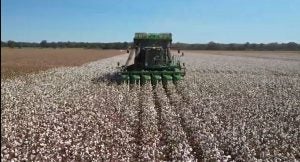The Ukraine-Russia war has reignited speculation that globalization is coming to an end and markets should prepare to turn inward in order to deal with disrupted supply lines and geopolitical challenges. While the war will undoubtedly have some long-lasting implications, according to a new Quarterly report from CoBank’s Knowledge Exchange, an unwinding of global supply chains and world markets is unlikely to be one of them.
Economic sanctions are creating dividing lines between countries. But the war will not diminish the need for global trade, which set a new record in 2021 at $28.5 trillion. A complete reversal of long-established global interdependencies is very unlikely, particularly in the commodity sectors.
The report notes that U.S. economic fundamentals remain strong: The unemployment rate is essentially back to its pre-pandemic level, consumers are spending and wages are rising. But consumer dollars aren’t going as far as they did last year and the Federal Reserve is determined to tame inflation, no matter the cost.
“Cooling demand will probably take more Fed action than most currently expect,” said Dan Kowalski, vice president of CoBank’s Knowledge Exchange. “While interest rates are rising, financial conditions are still quite loose relative to the level of inflation. Real, or inflation-adjusted rates remain deeply negative, maintaining a stimulative effect on the economy. In total, we expect the Fed to raise rates by 250 basis points in 2022. But we won’t be surprised if they need to do more.”

Whether or not inflation has peaked, it should begin to decline by this summer. Base effects will play an increasing role in coming months, and the rise in commodity prices since the start of the Ukraine-Russia war should moderate. Trucking rates have come off their highs and some transportation bottlenecks have been easing. All of these are positive signs and likely signal that inflation is near its ceiling.
Grains, Farm Supply & Biofuels
Russia’s invasion of Ukraine roiled global grain trade and contributed to unprecedented price volatility in wheat, corn, and soybeans during quarter one. Grain markets could remain volatile for two or more years due to disruptions in planting, harvesting, input application, and transportation. The USDA’s most recent Prospective Plantings report had bullish implications for corn and wheat, and a bearish surprise for soybeans. For only the third time in history, U.S. farmers are expected to plant more acres of soybeans than corn.
Prices for major fertilizers increased between 8 percent and 13 percent in quarter one, with the biggest spikes coming after Russia invaded Ukraine. While most U.S. ag retailers have adequate nutrient supplies this spring, that may not be the case this fall and in spring 2023. Russia, Ukraine, and Belarus are usually major exporters of nitrogen, phosphate, and potash fertilizers, as well as natural gas, the key feedstock for nitrogen fertilizers. Those supplies will remain threatened by production shutdowns and export restrictions and fertilizer prices will be elevated throughout 2022.
Ethanol producers have maintained positive margins since the outbreak of the war, but the situation may reverse in quarter two. Ethanol prices rose 8% from the day of the invasion (February 24) through March 31, exceeding the 5% increase in corn feedstock costs. However, ethanol refineries fuel their boilers with natural gas, so producer margins will suffer if U.S. natural gas prices remain at unusually high levels.
Animal Protein & Dairy
Escalating feed costs continue to stifle growth in the U.S. animal protein sectors. Feed supply challenges have been exacerbated by the risk to global grain stocks due to the war in Ukraine. Higher energy prices and an ongoing labor supply crunch are additional headwinds for the protein sector. However, prices for livestock, meat, and poultry have continued higher, promoting cautious optimism for producers.
Food service sector demand appears to be finding consistency as the omicron wave of COVID-19 has subsided. As grilling season begins, robust demand is expected to continue to pressure supplies despite rising retail prices for meat and poultry.
After minimal impact over the past five years, Highly Pathogenic Avian Influenza (HPAI) has again been reported in U.S. commercial poultry flocks this year, claiming more than 20 million head so far, the largest total since 2015. Losses have primarily been for turkey and table egg producers.
Milk supplies tightened further last quarter as rising production costs continued to burden U.S. dairy producers. Strong international demand for dairy products coupled with falling global supplies continues to bolster U.S. exports, signaling strong support for dairy product prices in the months ahead. Chinese demand will be a central focus in quarter two as policy makers for the world’s largest importer of commodities struggle to contain escalating food prices. Efforts to stockpile commodities may translate into new demand for U.S. dairy products.

Cotton, Rice & Specialty Crops
Cotton prices were initially slow to react to the invasion of Ukraine, but nearby futures eventually climbed to $1.40/lb., the highest since 2011. Rainfall levels in West Texas will be the primary driver of U.S. cotton prices in 2022. West Texas cotton crops account for roughly 35 percent of total U.S. production. The difference between poorly timed rains in 2020 versus adequate rain in 2021 in West Texas led to a 3 million bale increase in cotton production, which is equivalent to 6.5 percent of all global exports. The U.S. provides more than 40 percent of global cotton exports.
The USDA’s Prospective Plantings report predicts 2022 long-grain rice planted acreage in the U.S. will fall to 1.94 million acres, particularly in the chief rice-producing state of Arkansas. For the first time since 2007, acres planted to long-grain rice are expected to decline for two consecutive years as world rice prices remain tepid compared to other crops. The USDA also predicted medium- and short-grain rice planted acreage will fall for the third consecutive year to 509,000 acres — the lowest on record — as growers in California face another year of ongoing drought.
Specialty crop growers in the Western U.S. are bracing for a third year of drought and limited water for irrigation. The California Department of Water Resources reports snowpack at 38 percent of average as the wet season ends. Freezing temperatures in February further reduced prospects for the 2022 California almond crop. Early estimates put frost damage at roughly 10 percent. Nut prices have been hurt as transportation and logistics issues slow exports, raising the likelihood of record carryout at the end of the marketing year on July 31.
The USDA estimated Florida’s orange crop at a meager 41 million boxes — the smallest Florida orange crop since 1943 as the Orange State continues to struggle with citrus greening disease. Imports of fresh pack oranges, meanwhile, continue to climb.


